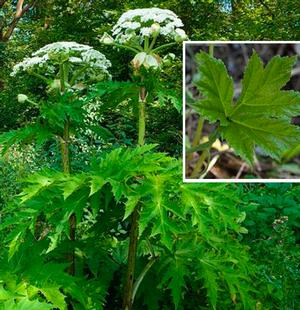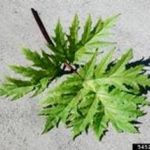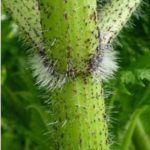Do Not Touch This Plant: If you come in contact with this plant, you could experience severe burns to your skin, and risk temporary or permanent blindness.
Giant Hogweed is an invasive, non-native plant that poses a serious threat to human health and natural ecosystems.
If you haven’t already heard, Giant Hogweed has now been detected in many counties across Michigan. The Michigan Department of Agriculture & Rural Development states on its website, “Giant Hogweed is a public health hazard that ranks up there higher than poison ivy, poison oak and poison sumac in respect to its potential to harm humans.”
Key identifying features
Height: Between 7 and 14 feet tall (depending upon growth stage and if mowed or cut)
Leaves: Huge leaves, incised and deeply lobed up to 5 feet across
Stems: Green with extensive purple splotches and prominent coarse white hairs. Stems are also hollow, ridged, 2-4 inches in diameter, and have a thick circle of hairs at base of leaf stalk
Flowers: White flowers with 50-150 flower rays clustered into an umbrella shaped flower cluster up to 2.5 feet across
The reason for concern is that the sap from this plant can cause a severe skin reaction known as photo-dermatitis or photo-sensitivity. The reaction can happen up to 48 hours after contact. After coming in contact with the sap, the skin blisters when exposed to sunlight. Contact with the eyes can lead to temporary or possibly permanent blindness. The weed can be especially troublesome for children that may find the long stems attractive to play with. If you do come into contact with the plant, and especially the sap, you are advised to wash the affected areas immediately, keep the exposed area out of direct sunlight and seek medical advice.
Besides these public health concerns, Giant Hogweed is also reported to be invasive under certain conditions. It does especially well in disturbed soils and also along waterways where seeds can be spread long distances. Large colonies have been known to form from a single plant, where an abundance of seeds coupled with shoots arising from the roots gives rise to dozens of offspring. Weed specialists have reported that once it becomes established, it takes up to five years to completely eradicate a colony due to regrowth from seeds and roots.
Learn more about Giant Hogweed and common look-a-likes at http://msue.anr.msu.edu/uploads/files/E2935_2012_Revision.pdf




